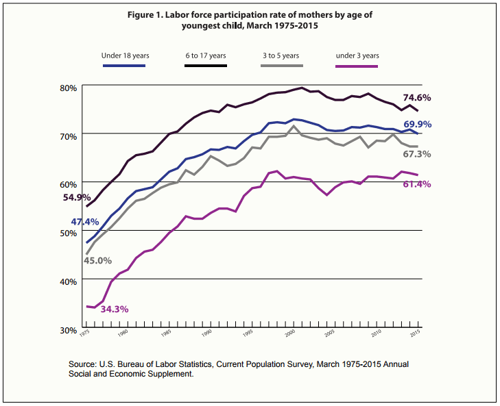Today, women comprise 47% of the U.S. workforce. In 2015, the U.S. Labor Department estimated that 70% of all mothers with children under 18 participated in the labor force, representing 34% of all working women. Over the past thirty years, the percentage of working moms has climbed steadily. Today’s 70% participation reflects a 50% increase from a participation rate of 47.4% in 1974.

As working mothers have become an increasingly important part of the labor force, employers have taken notice. For many employers, an important issue is identifying and implementing high quality, cost-effective benefits for working mothers.
Benefits for working mothers
As they balance family and work responsibilities, all working parents—including working mothers—live tightly scheduled, inherently stress-filled lives. Almost any event, which interferes with a working mother’s busy schedule has the potential to become a high stress nightmare. As a result, many of the best benefits for working mothers focus on low-cost ways to provide flexibility, to minimize the stress of unanticipated events, and to manage life’s necessities. They include:
1. Backup Care: While just 4% of employers offer this service, 89% of the Working Mother 100 Best Companies provide it. For dedicated working parents, it can be a “lifesaver.” If a child is sick, school is suddenly cancelled, or the caregiver for a younger child is unable to work, backup care provides a subsidized nanny who provides in-home child care, when it’s unexpectedly necessary. The potential stress caused by a change in the finely balanced routine or working parents is eliminated, and the benefits ensures both mom and dad can meet their obligations at work, while maintaining their focus and productivity.
2. Telemedicine: There are few things a working mother or father dreads more than the sudden crying of a young child in the middle of the night. Does the child have a serious condition? Does one parent need to take the child to the Emergency Room immediately. Alternatively, does a parent spend a sleepless night worrying about the health of the child, and then miss at least a half a day of work taking the child to see a physician. With a 24-hour telemedicine benefit, a working mother can quickly receive an almost instant opinion on the need for an immediate E.R. visit, or an in-office visit the following day. In many cases, through a middle of the night virtual telemedicine consult, the doctor can diagnose the child’s illness and (as appropriate) order a prescription at an all-night pharmacy. A telemedicine benefit enables working moms and dads to avoid the stress and uncertainty associated with their child’s health, unnecessary and expensive middle-of-the-night E.R. visits, and unnecessary physician or urgent care visits the next day. With the issue quickly resolved, their overall stress is far lower, and they may even enjoy a decent night’s sleep.
3. Sick Leave that Applies when A Child Is Sick: Many parents are uncomfortable leaving a sick child at home with an unfamiliar caregiver. One alternative for employers: Allow working mother and fathers to use their sick days when their children are sick.
4. Flex Spending for Child Care Expenses: Most of us are familiar with flex spending accounts for healthcare. Employers can offer similar accounts for child care expenses, allowing working parents to pay up to $5,000 child care costs with pre-tax dollars. For working moms, these savings can be significant.
5. Flexible Work Schedules, with Work-At-Home Options: The statistics show that most primary caregivers are women. As working mothers juggle work and family obligations, scheduling options that, for example, enable working moms to be home after school, some or all days, are a benefit that has high value.

6. On-Site Day Care: Over the past seven years, increases in child-care costs have outpaced inflation by about 21%. In many cases, on-site company day care makes it worthwhile for lower salaried working women to stay in the workforce. Patagonia, which introduced on-site daycare over 30 years ago, has seen higher retention rates among working moms. This benefit builds employee engagement, loyalty and productivity.
7. Concierge Services and On-Site Amenities: For professional women, the difficulty of finding the time to “do it all” can be particularly daunting. Indeed, one survey found that 93% of professionals admitted to taking care of chores during working hours. Companies that arrange for workplace concierge solutions that connect busy parents with vetted services—ranging from dog-walkers, to dry-cleaning, to home cleaning services, increase the productivity of their working parents, reduce worker stress, and improve employee engagement. Employers that offer on-site resources to reduce the friction involved in maintaining the other necessities of a balanced life, ranging from exercise classes, to Yoga and other offerings associated with well-being, with the necessary showers and other facilities, realize similar benefits.